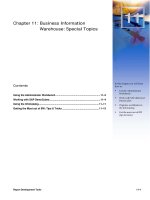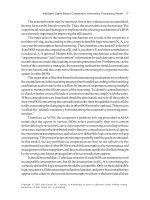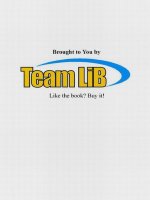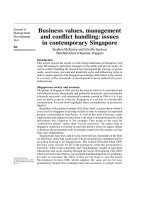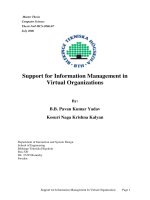Business information management exercises
Bạn đang xem bản rút gọn của tài liệu. Xem và tải ngay bản đầy đủ của tài liệu tại đây (4.15 MB, 39 trang )
In cooperation with www.beam-eBooks.de
Benson V. & Davis K.
Business I nform at ion Managem ent
Exercises
Download free books at BookBoon.com
2
In cooperation with www.beam-eBooks.de
Business I nform at ion Mam agem ent : Exercises
© 2008 Benson V., Davis K. & Vent us Publishing ApS
I SBN 978- 87- 7681- 414- 4
Download free books at BookBoon.com
3
In cooperation with www.beam-eBooks.de
Business Information Management: Exercises
Contents
Cont ent s
Preface
6
1.
1.1
1.2
1.3
Introduction to Information Management
Summary
Answers to the Review Questions
Case Study: Walmart Harnesses RFID Technology to Improve Efficiency
8
8
8
12
2.
2.1
2.2
Relational Data Model and SQL
Summary
Solutions to Exercises
13
13
14
3.
3.1
3.2
Data Definition in SQL
Summary
Solutions to Exercises – DDL and DML activities
17
17
18
4.
4.1
4.2
Advanced Selection Queries
Summary
Solutions to Exercises – Order As and Selection
20
20
20
5.
Joining Tables
5.1 Summary
5.2 Solutions to Exercises – Join, Selection and Projection
24
24
24
© 2008 KPMG Deutsche Treuhand-Gesellschaft Aktien gesellschaft Wirtschaftsprüfungsgesellschaft, eine Konzern gesellschaft der KPMG Europe LLP und Mitglied des KPMG-Netzwerks unabhängiger
Mitglieds firmen, die KPMG International, einer Genossenschaft schweizerischen Rechts, angeschlossen sind. Alle Rechte vorbehalten.
Please click the advert
Globales Denken. Gemeinsame Werte. Weltweite Vernetzung.
Willkommen bei KPMG.
Sie haben ehrgeizige Ziele? An der Hochschule haben Sie überdurchschnittliche Leistungen erbracht und suchen
eine berufliche Herausforderung in einem dynamischen Umfeld? Und Sie haben durch Ihre bisherigen Einblicke in
die Praxis klare Vorstellungen für Ihren eigenen Weg und davon, wie Sie Ihr Potenzial in eine berufliche Karriere überführen möchten?
Dann finden Sie bei KPMG ideale Voraus setzungen für Ihre persönliche und Ihre berufliche Entwicklung. Wir freuen
uns auf Ihre Online-Bewerbung für einen unserer Geschäftsbereiche Audit, Tax oder Advisory.
www.kpmg.de/careers
Download free books at BookBoon.com
4
In cooperation with www.beam-eBooks.de
Business Information Management: Exercises
Contents
6.
6.1
6.2
Functions, Aggregate and Group-set Functions
Summary
Exercises
28
28
28
7.
7.1
7.2
Information Security Management
Suggested Discussion Points for Exercises
External Resources and Links
31
31
38
Please click the advert
Lernen Sie ein paar nette Leute kennen. Online im sued-café.
affenarxxx
krixikraxi
burnout
bauloewe
olv
erdonaut
catwoman
ratatatata
franz_joseph
cuulja
leicestermowell
irma*
borisbergmann
traumfaenger
angus_jang
sixpence
schuetzenlisl
bgraff
nicht_ich
audiosmog
auto_pilot
vorsicht
neutralisator_x
dhaneberg
Bis gleich auf sueddeutsche.de
www.sueddeutsche.de/suedcafe
Download free books at BookBoon.com
5
In cooperation with www.beam-eBooks.de
Business Information Management: Exercises
Preface
Preface
Information management is vital for today’s businesses. It requires significant investment and
supports critical business processes. With the proliferation of the information economy and
information systems, effective information management determines success of virtually every
business operation. Obtaining business value from vast amount of information collected by
businesses is no longer only a technological challenge. The choice of decision making tools and
information solutions rests with the business, as well as with IT managers.
Key Feat ures
Each chapter provides a comprehensive coverage of relevant theory concepts followed by review
questions, and/or case studies and worked examples. Many practical examples are included to
illustrate the data analysis concepts. These exercises should help students acquire hands on skills,
prepare for assessment and solve types of problems encountered in employment. The book is
supported by:
A downloadable versions of the database files used in this book
Solutions for instructors
Starting with a general introduction to information management the text takes the reader through
the essential concepts of data analysis in Microsoft™ Access 2007. It presents an overview of the
relational data model and data management using SQL. The data analysis chapters start with the
preliminary concepts of database organisation and a gentle introduction to basic SQL. Further
chapters introduce more advanced concepts of built-in functions, joining information from
several tables and nested queries. We conclude with an overview of information security issues
which represent significant challenges to businesses today.
This handbook provides solutions to the following:
CHAPTER 1 INTRODUCTION TO INFORMATION MANAGEMENT:
ANSWERS TO REVIEW QUESTIONS
SUGGESTED DISCUSSION FOR THE CASE STUDY: WALMART HARNESSES RFID TECHNOLFGY TO
IMPORVE EFFICIENCY
CHAPTER 2 RELATIONAL DATA MODEL AND SQL:
SOLUTIONS TO EXERCISES
CHAPTER 3 DATA DEFINITION IN SQL:
SOLUTIONS TO EXERCISES
CHAPTER 4 ADVANCED SELECTION QUERIES:
SOLUTIONS TO EXERCISES
Download free books at BookBoon.com
6
In cooperation with www.beam-eBooks.de
Business Information Management: Exercises
Preface
CHAPTER 5 JOINING TABLES:
SOLUTIONS TO EXERCISES- JOIN, SELECTION AND PROJECTION
CHAPTER 6 FUNCTIONS, AGGREGATE AND GROUP-SET FUNCTIONS:
SOLUTIONS TO EXERCISES
CHAPTER 7 INFORMATION SECURITY MANAGEMENT
SUGGESTED DISCUSSION POINTS FOR EXERCISES
EXTERNAL LINKS
The hands-on exercises in Chapters 2 through 6 are based on the following scenario:
Dream Destinations Ltd is a company that provides a top quality service in bespoke, tailor-made
holiday packages. They arrange everything from flights, hotel accommodation and trips to
destinations within the Caribbean. At present they only record data from phone calls and e-mails
on paper note pads and these are put inside filing cabinets. They have no methods for storing
customer, hotel or flight information and have difficulty in keeping track of information. They
only advertise by word of mouth, cold calling telesales and advertising through print media such
as their own travel brochure which can be found in travel agents.
Dream Destinations Ltd have realised that should something happen to the paper files, e.g. an
office fire, their data would be lost as they have no way of keeping data. They want to be able to
access the required information quickly and efficiently. They also need a means of advertising
themselves to increase their customer base. They have asked for us to create a means of storing
their client, booking and property information.
The exercises in Chapters 2 through 6 require download of the following database file:
SQLLabSessions.accdb
The SQLLabSessions database contains four tables, PROPERTY, OWNER, CLIENT and
BOOKING.
property is a table containing property to be rented out information such as property
number, street, country, rental cost and the yearly income.
owner is a table containing the details of the owners of the properties.
client contains the details of people who want to rent the properties.
booking contains the details of clients who have booked a stay at a property.
The aim of this book is to assist managers in becoming knowledgeable decision makers in the
field of information management and analysis. This textbook covers methods of information
analysis using relational databases written for current and future managers. The text finishes with
an overview of current threats to business information assets and approaches to their mitigation.
Download free books at BookBoon.com
7
In cooperation with www.beam-eBooks.de
Business Information Management: Exercises
Introduction to Information Management
1. I nt roduct ion t o I nform at ion Managem ent
1.1 Sum m ary
Information is the backbone of operations and survival for any modern business. Information is
distinguished from data as a result of data processing operations. After data is processed and
shaped in a meaningful form useful in business environment, it turns into information. In order to
be useful to business and effectively support business processes, data is typically organised using
a particular data model. A data model determines how data items are arranged into a hierarchy
comprising of data elements and data structures. Data items are characterised by a data type.
Standard data types include numbers, text, date and time units, with more complex data types are
now available. In order to distinguish various types of information processed and generated in a
business organisation it is necessary to distinguish between strategic, management and
operational levels in an organisation. Information required by each level differs in its origin
(external or internal to organisation), time frame (long, medium or short term), level of detail, etc.
How a business aligns its information assets with its business objectives is stated in the
information strategy document. Whereas practices on information capture, use, risks and security
are typically specified in an information policy.
Ever-increasing complexity of modern business has lead to the emergence of a wide range of
software designed to help business derive value from their information assets. Such software
ranges form spreadsheets to integrated Enterprise Resource Planning Systems (ERP) with more
and more emphasis being put onto collaboration and communications features of modern
software.
1.2 Answers t o t he Review Quest ions
1. What are the major differences between data and information?
Answer: Raw, unprocessed streams of facts are usually referred to as data. Entries of
numbers, text, images or other forms of computerized output are considered data. Raw data,
however, is a relative term as data processing may have a number of stages, so the output
from one processing stage can be considered to be raw data for the next. After, data is
processed and shaped in a meaningful form useful to a person or computer, it turns into
information.
2. Outline some characteristics of information typically required for strategic decision
making.
Download free books at BookBoon.com
8
In cooperation with www.beam-eBooks.de
Business Information Management: Exercises
Introduction to Information Management
Answer: Senior management will focus on general, or strategic, issues related to overall
business development in the long term. At this level decisions tend to relate to issues with
long term such as restructuring, major financial investments and other strategic undertakings
related to company’s future rather than present. Information necessary for decision making at
this level is comprehensively gathered not only from the internal sources of the company
itself, but also involves external information, such as data related to economic situation or
sectors as a whole.
3. Distinguish between the types of information used for operational and management
decision making?
Answer: At the operational level decisions are made to ensure smooth running of
operational processes or day-to-day business. At this level it is necessary to oversee that
resources are used efficiently, inventory is up to date, production levels are as planned, etc.
Decision making at this level requires information almost entirely internal to the company,
although it may be extremely detailed and real-time.
Information for decision making at management level has a typical timeframe ranging from
weeks to several month or a year. Middle management usually controls medium term
scheduling, forecasting and budgeting operations. These rely on internal as well as
occasional external information. For instance, setting the quarterly budget requires the
knowledge of current expenditure as well as external pricing information.
Please click the advert
WHAT‘S MISSING IN THIS EQUATION?
You could be one of our future talents
MAERSK INTERNATIONAL TECHNOLOGY & SCIENCE PROGRAMME
Are you about to graduate as an engineer or geoscientist? Or have you already graduated?
If so, there may be an exciting future for you with A.P. Moller - Maersk.
www.maersk.com/mitas
Download free books at BookBoon.com
9
In cooperation with www.beam-eBooks.de
Business Information Management: Exercises
Introduction to Information Management
4. Describe the constructs of a data model? What is the purpose of specifying data types?
Answer: In order to be useful to business and effectively support business processes, data is
typically organised using a particular data model. A data model determines how data items
are arranged into a hierarchy comprising of data elements and data structures. Data items are
characterised by a data type. Standard data types include numbers, text, date and time units,
with more complex data types are now available.
5. Describe how data elements such as letters in English alphabet are represented on
computer hardware?
Answer: Standard data types, such as text – a series of characters composed of characters
from the alphabet and other symbols, numbers - integer, decimal, float and other types of
numbers, and time including dates, seconds, minutes and hours, are among most commonly
used in business information systems. Computers and other electronic devices store data
using strings of characters coded based on a standard character set. Although invisible to an
average computer user, encoding character set represents a standardised coding scheme. For
instance, text consists of symbols or letters, each letter or punctuation mark has a
corresponding sequence of symbols from the encoding set uniquely representing this text
element for hardware and software manipulation. ASCII – American Standard Code for
Information Interchange- has become a default standard character sets used on most personal
computers and workstations. The ASCII coding scheme, based on the English alphabet,
provides encoding for 128 symbols. In ASCII the capital A is represented by the binary
string or word 10100001.
6. What kinds of software applications are used for handling operational data as well as
generating strategic information?
Answer: Database Management Systems (DBMS) permit to efficiently manage, secure and
analyse data, as well as interface to other software applications
7. What document specifies how an organisation handles its information?
Answer: To provide specific guidelines to their employees, contractors, trading partners and
other external stakeholder on the processing, storage and communication of various types of
information, business firms usually create an information policy document. This document is
extremely important when an organisation handles security sensitive data or is subject to
government guidelines related to information processing. It defines sensitivity levels of
information and lists who has access to each level. The aim of the information policy is to make
sure that information assets of a company are appropriately protected from threats or disclosure.
Download free books at BookBoon.com
10
In cooperation with www.beam-eBooks.de
Business Information Management: Exercises
Introduction to Information Management
8. What is the purpose of an information strategy document?
Answer: An information strategy is developed to support the overall business strategy of an
organisation and explains how information should be captured, processed, used and disposed
of throughout its lifecycle. Although the structure of an information strategy varies from
business to business, there are some common areas included in most information strategy
documents such as:
Overview of Information
Resources
Information Architecture
and IT Structure
External Factors
Opportunities
Risk Analysis
Schedule
Summary of resources, their utilisation by internal staff and
external stakeholders, key projects, budgeting, etc.
Description of the IT infrastructure, key projects, itemisation of
data sources and their purpose.
Analysis of the competition, the economy, government policy
and technological advances.
Analysis of new business opportunities arising from
information and technologies.
Description of internal and external threats, analysis of
compliance with regulations, summary of information usage by
competitors.
List of milestones and review dates to indicate if the strategy is
executed well.
9. What problems arise when information becomes decentralised in a business organisation?
Answer: Without an organisation-wide plan and data administration procedures in place
business
Datamay
redundancy
encounter–such
whereas
problems
data becomes
as:
duplicated and stored at several locations in
more than one file.
Poor Data Availability – data becomes isolated and available only to the owner of a
particular file in a file system. Sharing of data and its visibility to employees becomes
reduced.
Poor Data Security – data spread across business in various forms and locations reduce
the ability of a business to set proper security controls and ensure authorised access to
information.
Error-Prone Data – when same data exists at multiple locations it become more
vulnerable to human errors introduced by different employees and mistakes tend to go
unnoticed for longer.
10. Give an example of how information systems support major business processes in sales,
finance, production or human resources?
Download free books at BookBoon.com
11
In cooperation with www.beam-eBooks.de
Business Information Management: Exercises
Introduction to Information Management
Answer: The Sales department stores data about customer orders. Finance and Accounting
use sales data to generate invoices and process payments. The Marketing department draws
on the customer data and sales information for effective marketing campaigns. Human
Resources store information about company employees, their skills and professional
development needs. The central database facilitates keeping track of stock and production
levels for manufacturing and production areas of business. Centralised information helps
even a small business run effectively and rely on real-time information.
1.3 Case St udy: Walm art Harnesses RFI D Technology t o I m prove
Efficiency
Recommended Sources:
Please click the advert
[1] />[2] />[3] />[4] />[5] />
Download free books at BookBoon.com
12
In cooperation with www.beam-eBooks.de
Business Information Management: Exercises
Relational Data Model and SQL
2. Relat ional Dat a Model and SQL
2.1 Sum m ary
Relational Database Management Systems (RDBMS) have become the prevalent means of
managing data. RDBMS comprises of software facilitating storage, entry and data retrieval.
Relational databases are organised in entities, attributes, and tuples. A tuple (or a record) is a set
of attributes. An attribute contains a single piece of information, and an entity is a collection of
tuples. Relations in a database are represented using entities (or tables), with rows containing
unique tuples. A cell must hold one atomic value (e.g. a value that wouldn’t normally be divided
into any smaller parts). Values can be Text (e.g. letters or Alphanumeric characters), Numbers
(so that associated mathematical operations can be performed) or other types such as Dates,
Times or Currency.
Standard Query Language (SQL) is the most widely-accepted database language, supported to
some extent by every database product on the market today. Data retrieval in a database is
performed using queries written in a query language. A Query can be classified as a question that
we require the database to provide an answer to. The Select statement is used in SQL to pull
out and display information from a table. Its basic structure has this form:
SELECT select-list
FROM table;
In addition to data retrieval, SQL supports other operations for managing data. These include:
Select
Insert
Delete
Update
Create
Alter
Drop
Grant
Revoke
Validate
Used to retrieve data from the database, the most commonly used
statement
Used to enter (insert), remove (delete) or change (update)
rows from a table. Together with Select, collectively known as
the DML or Data Manipulation Language
Used to set up (create), change (alter) or remove (drop)
data structures such as tables, views or indexes. Collectively
known as the DDL or Data Definition Language
Used to give (grant) or remove (revoke) access rights to data
and data structures within an SQL database
Download free books at BookBoon.com
13
In cooperation with www.beam-eBooks.de
Business Information Management: Exercises
Relational Data Model and SQL
Exercises in this chapter are based upon the following scenario:
Dream Destinations Ltd is a company that provides a top quality service in bespoke, tailor-made
holiday packages. They arrange everything from flights, hotel accommodation and trips to
destinations within the Caribbean. At present they only record data from phone calls and e-mails
on paper note pads and these are put inside filing cabinets. They have no methods for storing
customer, hotel or flight information and have difficulty in keeping track of information. They
only advertise by word of mouth, cold calling telesales and advertising through print media such
as their own travel brochure which can be found in travel agents.
Dream Destinations Ltd have realised that should something happen to the paper files, e.g. an
office fire, their data would be lost as they have no way of keeping data. They want to be able to
access the required information quickly and efficiently. They also need a means of advertising
themselves to increase their customer base. They have asked for us to create a means of storing
their client, booking and property information.
2.2 Solut ions t o Exercises
1. Display all the information in the table called client
SQL: SELECT * FROM client;
2. Display the propertyno and country for each property
SQL: SELECT propertyno, country FROM property;
Download free books at BookBoon.com
14
In cooperation with www.beam-eBooks.de
Business Information Management: Exercises
Relational Data Model and SQL
3. Display all the distinct types of property
SQL: SELECT DISTINCT type FROM property;
4. Display a list of the monthly income of each rental property (calculated from yearly
income / 12)
SQL: SELECT propertyno,ownerno, yearincome/12, FROM property;
Please click the advert
Studieren in Dänemark heißt:
nicht auswendig lernen, sondern verstehen
in Projekten und Teams arbeiten
sich international ausbilden
mit dem Professor auf Du sein
auf Englisch diskutieren
Fahrrad fahren
Mehr Info: www.studyindenmark.dk
Download free books at BookBoon.com
15
In cooperation with www.beam-eBooks.de
Business Information Management: Exercises
Relational Data Model and SQL
5. Display a list of the distinct property locations
SQL: SELECT DISTINCT country FROM property;
6. Display the property number, and the new rent figure given a 12% rise in the rent figure.
Name the new column increase
SQL: SELECT propertyno, (rent/100*12)+rent AS increase FROM property;
7. Display the first name and last name of each client as a single column separated by a
hyphen (name the column clientname), along with new rent figure given a 5% increase
in the maximum rent figure (name the new column newmax)
SQL:SELECT fname&"-"&lname AS clientname, (maxrent/100*5)+maxrent AS
newmax , FROM client;
Download free books at BookBoon.com
16
In cooperation with www.beam-eBooks.de
Business Information Management: Exercises
Data Defi nition in SQL
3. Dat a Definit ion in SQL
3.1 Sum m ary
The SQL language has facilities to create, manipulate and delete (drop) tables. Often these command
line activities are duplicated through a GUI (such as the one in Access), however there are advantages
to performing these operations through text. The SQL create table syntax is of the form:
CREATE TABLE tablename
(column_name type [NULL/NOT NULL],
column_name type [NULL/NOT NULL],
column_name type [NULL/NOT NULL] ..)
To permanently delete a table (to ‘drop’ a table), use the drop command:
DROP table tablename;
To change a table structure use the alter table command:
ALTER table tablename
(
[MODIFY columnname type |
ADD columnname type ]
);
Most SQL queries allow views on the original data, without manipulating the original data set.
Actual changes to rows in a table ( or Data Manipulation) are done through the
Insert,Update or Delete statements. The INSERT statement adds records (rows) to a
table and has two forms:
INSERT into table [(columnname, columnname, …)]
values (value, value,…)
This will insert a record using a supplied column list the supplied values. If no column list is
supplied the record will be inserted as is, which may generate errors if the columns don’t match up.
INSERT into table [(columnname, columnname, …)]
select select-list
from table(s) … etc.
This form allows an insert to be based on the results of a select query.
Download free books at BookBoon.com
17
In cooperation with www.beam-eBooks.de
Business Information Management: Exercises
Data Defi nition in SQL
3.2 Solut ions t o Exercises – DDL and DML act ivit ies
Write SQL commands to perform the following activities:
1. Create a specialised property table called propertyBarbados, which has the same field names
as the property table.
SQL:
CREATE TABLE propertyBarbados
(
propertyno char(15),
street char(15),
country char(15),
type char(15),
rooms number,
rent number,
yearincome number,
ownerno char(15)
);
2. Write an appropriate SQL query to insert a new property into propertyBarbados with the
following details:
propertyno – BD67
street – Sunrise St
country – Barbados
type - Villa
rooms - 7
rent – 600
year income - 14000
ownerno – CO96
SQL:
INSERT INTO propertyBarbados (propertyno, street, country, type,
rooms, rent, yearincome, ownerno)
VALUES (“BD67”, “Sunrise St”, “Barbados”, “Villa”, 7, 600, 14000,
“CO96”);
Download free books at BookBoon.com
18
In cooperation with www.beam-eBooks.de
Business Information Management: Exercises
Data Defi nition in SQL
3. Write a query that will insert the details of other properties in Barbados into the table
SQL:
INSERT INTO propertyBarbados (propertyno, street, country, type,
rooms, rent,
yearincome, ownerno)
SELECT propertyno, street, country, type, rooms, rent,
yearincome, ownerno
FROM property
WHERE country=“Barbados”;
4. Write an SQL statement to drop the propertyBarbados table
SQL:
DROP TABLE propertyBarbados;
wanted: ambitious people
Please click the advert
At NNE Pharmaplan we need ambitious people to help us achieve
the challenging goals which have been laid down for the company.
Kim Visby is an example of one of our many ambitious co-workers.
Besides being a manager in the Manufacturing IT department, Kim
performs triathlon at a professional level.
‘NNE Pharmaplan offers me freedom with responsibility as well as the
opportunity to plan my own time. This enables me to perform triathlon at a competitive level, something I would not have the possibility
of doing otherwise.’
‘By balancing my work and personal life, I obtain the energy to
perform my best, both at work and in triathlon.’
If you are ambitious and want to join our world of opportunities,
go to nnepharmaplan.com
NNE Pharmaplan is the world’s leading engineering and consultancy
company focused exclusively on the pharma and biotech industries.
NNE Pharmaplan is a company in the Novo Group.
Download free books at BookBoon.com
19
In cooperation with www.beam-eBooks.de
Business Information Management: Exercises
Advanced Selection Queries
4. Advanced Select ion Queries
4.1 Sum m ary
The purpose of the SELECT statement in SQL is to retrieve data from one or more tables and
display the result in a required format. It is possible to select specific records from a database
according to a particular condition. Also, one may use ORDER BY to sort records after they have
been selected. The general form for the complete SELECT statement is given below:
SELECT [DISTINCT | ALL] {*| column [AS new_name]] [, …]}
FROM TableName [alias] [,…]
[WHERE conditional statement]
[GROUP BY column_list] [HAVING condition]
[ORDER BY column_list]
ORDER BY determines the order of the data retrieval output. The order of the clauses in a
SELECT statement cannot be changed, although some of the clauses are optional (enclosed in []
in the above syntax).
4.2 Solut ions t o Exercises – Order As and Select ion
In the following exercises, a query must be specified to produce the suggested result. There are
spaces for you to write SQL query statements. Use the AS command to get correct column
headings in SQL.
1. Display the property number, street and country information ordered by country.
SQL:
SELECT propertyno, street, country
FROM property
ORDER BY country asc;
Download free books at BookBoon.com
20
In cooperation with www.beam-eBooks.de
Business Information Management: Exercises
Advanced Selection Queries
2. Display the property number, street and country information ordered by country (descending)
and property number (ascending).
SQL:
SELECT propertyno, street, country
FROM property
ORDER BY country desc, propertyno asc;
3. Display the property information for properties that have less than 4 rooms.
SQL:
SELECT *
FROM property
WHERE rooms<4;
4. Display all the properties with 4 rooms and rent of over £540.
SQL:
SELECT *
FROM property
WHERE rooms=4 AND rent>540;
Download free books at BookBoon.com
21
In cooperation with www.beam-eBooks.de
Business Information Management: Exercises
Advanced Selection Queries
5. Display a list of client last names, preference type and the maximum rent figure with a
preference of Villas ordered by their maximum rent figure ascending.
SQL:
Please click the advert
SELECT lname, preftype, maxrent
FROM client
WHERE preftype=“Villa”
ORDER BY maxrent asc;
Download free books at BookBoon.com
22
In cooperation with www.beam-eBooks.de
Business Information Management: Exercises
Advanced Selection Queries
6. Show a list of clients who have made a comment ordered by property number descending.
SQL:
SELECT *
FROM booking
WHERE comment is NOT NULL
ORDER BY propertyno desc;
7. Display the property numbers, type, rent and owner number of those properties who have a
yearly income figure more than £11,000 and have 4 rooms, ordered by property number and type
ascending.
SQL:
SELECT propertyno, type, rent
FROM property
WHERE yearincome>11000 and rooms=4
ORDER BY propertyno asc, type asc;
Download free books at BookBoon.com
23
In cooperation with www.beam-eBooks.de
Business Information Management: Exercises
Joining Tables
5. Joining Tables
5.1 Sum m ary
More often than not SQL queries need to combine information from two or more tables. To join
records two or more tables together, SQL implements the equivalent of the mathematical
operation Cartesian Product. This is written in SQL by listing the tables to be connected
in the FROM clause, separated by commas.
A multi-table FROM statement is of the form:
FROM tablename [,tablename [,tablename …]]
Recall that the general form for the complete SELECT statement is:
SELECT [DISTINCT | ALL] {*| column [AS new_name]] [, …]}
FROM Tablename [alias] [, tablename]…
[WHERE conditional statement]
[GROUP BY column_list] [HAVING condition]
[ORDER BY column_list]
When records are retrieved from more than one table the WHERE clause MUST contain a
conditional statement indicating the keys which the tables are joined on. For example;
SELECT *
FROM property, owner
WHERE property.ownerno=owner.ownerno;
5.2 Solut ions t o Exercises – Join, Select ion and Proj ect ion
In the following exercises, the query must be specified to produce the suggested result. There are
spaces for you to write the SQL query. Use the AS command to get correct column headings in
SQL.
1. Display the owner first name and country of their properties.
SQL:
SELECT fname, country
FROM owner, property
WHERE property.ownerno=owner.ownerno;
Download free books at BookBoon.com
24
In cooperation with www.beam-eBooks.de
Business Information Management: Exercises
Joining Tables
2. Display the owner first and last name for Apartments in Antigua.
SQL:
SELECT fname, lname
FROM owner, property
WHERE property.ownerno=owner.ownerno AND type="Apartment" AND
country="Antigua";
Please click the advert
Ein ganz normaler Arbeitstag
für Tiger.
© 2008 Accenture. All rights reserved.
Von wo Sie auch starten,
entscheidend ist der Weg zum Ziel.
Entscheiden Sie sich für eine Karriere bei Accenture, wo vielfältige
Chancen und Herausforderungen auf Sie warten und Sie wirklich
etwas bewegen können – Tag für Tag. Wo Sie die Möglichkeit haben,
Ihr Potenzial zu entfalten und sich fachlich und persönlich weiterzuentwickeln. Trifft das Ihre Vorstellung von einem ganz normalen
Arbeitstag? Dann arbeiten Sie bei Accenture und unterstützen Sie
unsere globalen Kunden auf ihrem Weg zu High Performance.
entdecke-accenture.com
Download free books at BookBoon.com
25
In cooperation with www.beam-eBooks.de




